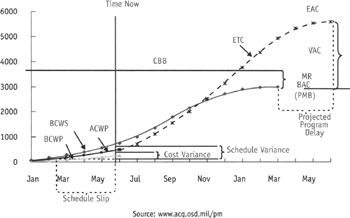The Background to Earned Value
|
Cost Schedule Control Systems Criteria
The earned value (EV) method of performance measurement had its origin in the Cost Schedule Control Systems Criteria (CSCSC) developed in the United States (US). As of today, it is the best industry standard tool for effectively integrating cost, schedule, and technical performance management. All work is planned, budgeted, and scheduled in time phased, "planned value" increments constituting a cost and schedule measurement baseline. There are two major objectives of an EV system: 1) to encourage contractors to use effective cost and schedule management control systems and 2) to permit the customer to be able to rely on timely data produced by those systems for determining the contract status.
Three basic indicators quantify the EV concept: they are the actual cost of work performed (ACWP), the budgeted cost of work performed (BCWP), and the budgeted cost of work scheduled (BCWS).
-
ACWP—Represents the costs actually incurred in accomplishing the work performed within a given time period.
-
BCWP—Is the EV. It signifies the value of completed work. BCWP is derived by determining the budget for all completed work, including the completed portions of in-progress work. In contrast to the traditional measurements of actual costs against the budget, earned value is the performance indicator of both cost and schedule. This dual characteristic of the BCWP provides the required integration. Instead of merely stating whether or not money is being spent as fast as it was planned, BCWP when compared to ACWP indicates whether the progress achieved is worth the money spent. In short, BCWP provides the required integration of physical progress, time, and cost.
-
BCWS—Indicates where the project manager planned to be by a certain date. It is the indicator of planned progress—the performance measurement baseline.
These three values determined at each reporting period and plotted cumulatively, provide a very precise picture of the performance of the work package against the budget and the schedule. Figure 1 shows the relationship between these curves.

Figure 1: The EVM Relationships
Inadequacy Defined
The present environment of Earned Value Management (EVM), as defined now in the profession, provides a very good and simplistic integration of cost and time. However, as our projects go through extensive mutation, rarely keeping variances to zero, inadequate robustness of the model becomes apparent. EVM only considers deviations from a one-dimensional BCWS. In order for the world to accept EVM as a separate management science in itself, the model needs to stretch into newer dimensions and horizons. Success need not only be related to the deterministic approach in pursuing a numerical goal.
Toward a Sensible Solution
The model reads occurring deviations only—but does not tell us when corrective actions are required to get back on course. Corrective action should only be directed at significant or important variances. It will not be productive to attempt corrective actions on all variances that may be temporary trends. This chapter shows an evolution of the BCWS, from a one-dimensional line first, to a two-dimensional polyline, and then its transition to a three-dimensional polyline, as the EV model strives to integrate the missing dimensions.
|
EAN: 2147483647
Pages: 207
- Telecommunications and Network Security
- Initiation of the System Authorization Process
- Appendix B Glossary of Terms and Acronyms
- Appendix C The Information System Security Architecture Professional (ISSAP) Certification
- Appendix D The Information System Security Engineering Professional (ISSEP) Certification